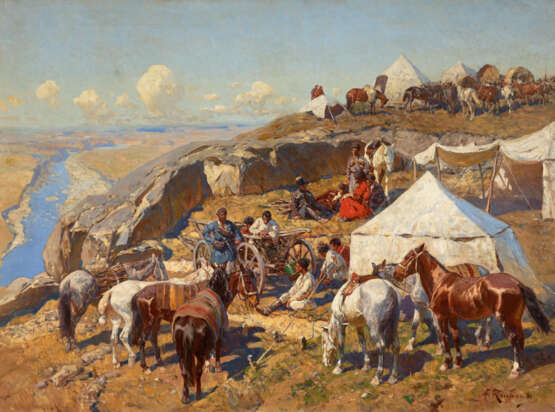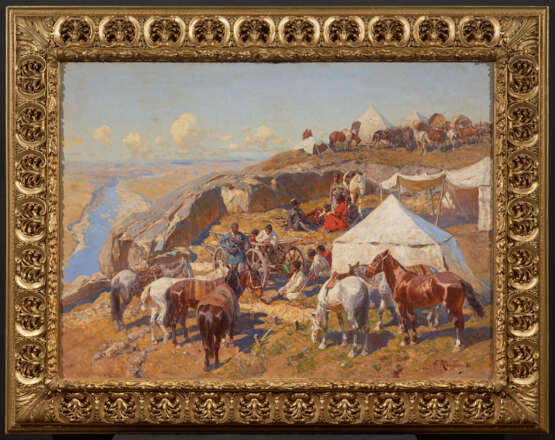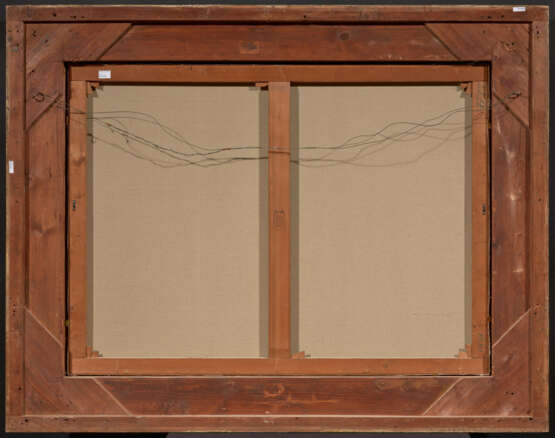ID 1424190
Lot 1311 | Equestrian Camp in the Caucasus Mountains
Valeur estimée
€ 100 000 – 150 000
Title: Equestrian Camp in the Caucasus Mountains.
Technique: Oil on canvas.
Mounting: Relined.
Measurement: 105.5 x 142cm.
Notation: Signed lower right: "F. Roubaud".
Frame: Framed.
Verso:
On the stretcher stamp of the Munich merchant for art supplies Hans Kellner.
Literature:
E. Lingenauber / O. Sugrobova-Roth: Franz Roubaud catalogue raisonné. Düsseldorf 2012, no. A 26-P in the digital addendum.
Provenance:
Since the end of the 1920s in private ownership, Germany.
In 2012, VAN HAM published the first monograph on the painter Franz Roubaud, which was created in collaboration with Olga Sugrobova-Roth and Eckard Lingenauber. Roubaud, born in 1856 in Odessa in what was the Russian Empire back then (now Ukraine), is regarded as one of the most important artists of the 19th and early 20th centuries today. With this publication, VAN HAM succeeded in closing a crucial gap in the history of art and establishing itself as the leading house for the study and marketing of Roubaud's works. Numerous works of art not included in this catalogue have been offered to us over the years and eventually required the creation of a digital addendum.
As part of the upcoming FINE ART auction on 16th May, we are pleased to present two works by Roubaud that are fascinatingly juxtaposed with regard to their execution and context. These works, which come from different ownerships and have been kept in the respective families for decades, are not included in the original catalogue raisonné. They now represent an exciting discovery that will be included in the digital addendum.
The two works were created in completely different phases of Roubaud's life and career, which provides a unique insight into the painter's artistic development. Roubaud, who together with his teacher Joseph von Brandt is today regarded as one of the most important representatives of the Munich School of Painting, shows a remarkable transformation in these works, from an early, detail-oriented realism to an expressive, almost impressionistic approach to painting. Cat. 1310 shows one of Roubaud's very first works from 1882, a small cabinet painting that reflects his early, controlled style. The precise execution, the militaristic subject and the attention to detail point to his formative years at the Munich Academy from 1877 on, where he studied under the masters Carl Theodor von Piloty, Otto Seitz, Wilhelm von Diez and Joseph von Brandt. During this time, Roubaud not only refined his painting skills, but also developed a passion for historical realism, military painting and the ethnological diversity of Central Asia.
Decades later - after an intensive artistic exchange between Paris and St. Petersburg, where he worked as a professor at the academy between 1903 and 1912 - he created "The Cossack Camp" (cat. 1311). This work measures approximately one metre by one and a half meters and marks the transition from a realistic to an almost impressionistic style of painting. Here Roubaud leaves detail painting behind and uses the power of colour to create the optical effect and three-dimensionality of the scene. The change in his technique illustrates the profound influences he absorbed in the art centres of the turn of the century.
Roubaud, who mastered the art of composition during this period, not only gave his works a new depth, but also gave the depicted scenes a dramatic liveliness. Light plays a decisive role, especially in the depiction of the horses, which the painter portrayed with great sensitivity. These animals, which he introduced to European art, were one of his great passions.
Olga Sugrobova-Roth, who examined the original painting in February 2025, confirms the authenticity of the work. The painting will be included in the digital addendum to the catalogue raisonné under cat. rais. no. A 26-P.
| Artiste: | Franz Roubaud (1856 - 1928) |
|---|---|
| Technique appliquée: | Huile |
| Catégorie maison de vente aux enchères: | Peintures de maîtres récents |
| Artiste: | Franz Roubaud (1856 - 1928) |
|---|---|
| Technique appliquée: | Huile |
| Catégorie maison de vente aux enchères: | Peintures de maîtres récents |
| Adresse de l'enchère |
VAN HAM Kunstauktionen GmbH Hitzelerstr. 2 50968 Köln Allemagne | ||||||||||||||
|---|---|---|---|---|---|---|---|---|---|---|---|---|---|---|---|
| Aperçu | |||||||||||||||
| Téléphone | +49 221 92586215 | ||||||||||||||
| Fax | +49 221 92 58 62 4 | ||||||||||||||
| Commission | 32% | ||||||||||||||
| Conditions d'utilisation | Conditions d'utilisation | ||||||||||||||
| Heures d'ouverture | Heures d'ouverture
|














